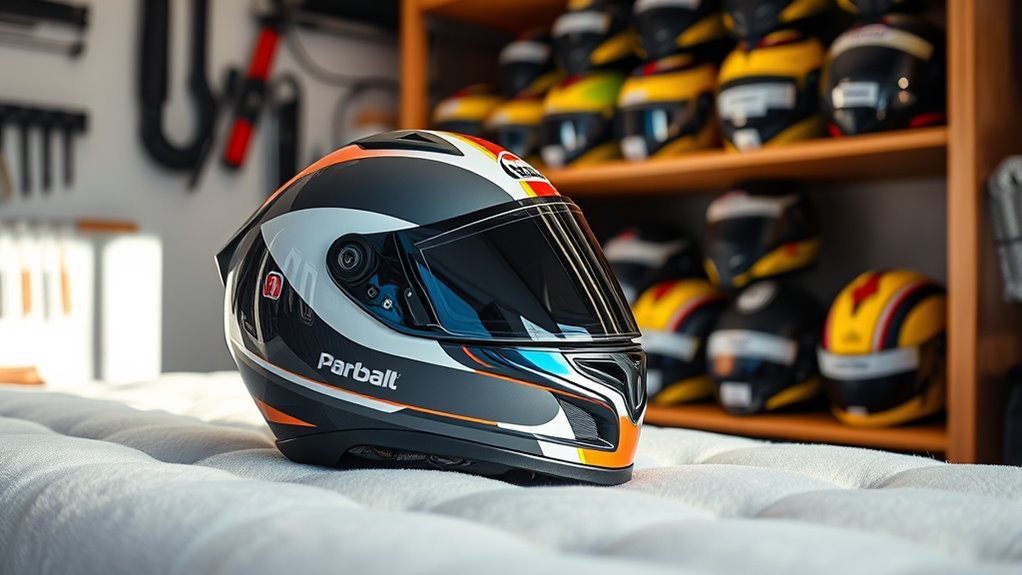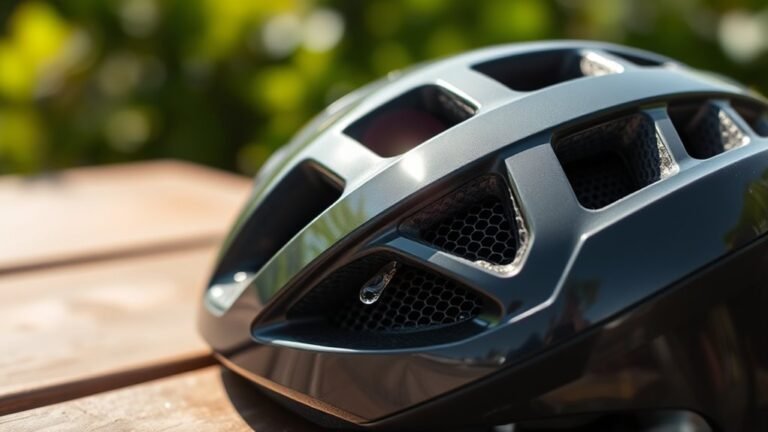Storing Your Helmet: Tips to Extend Its Lifespan
To extend your helmet’s lifespan, store it in a climate-controlled space. Avoid extreme temperatures and direct sunlight, which can degrade materials like polycarbonate and fiberglass. Clean it regularly with mild soap and disinfectant, and inspect for cracks or wear before storage. Use a dedicated area free from clutter to prevent impacts and scratches. Consider a helmet bag for added protection. For more detailed tips on maintenance and storage practices, you may want to explore further options.
Understand the Helmet’s Materials
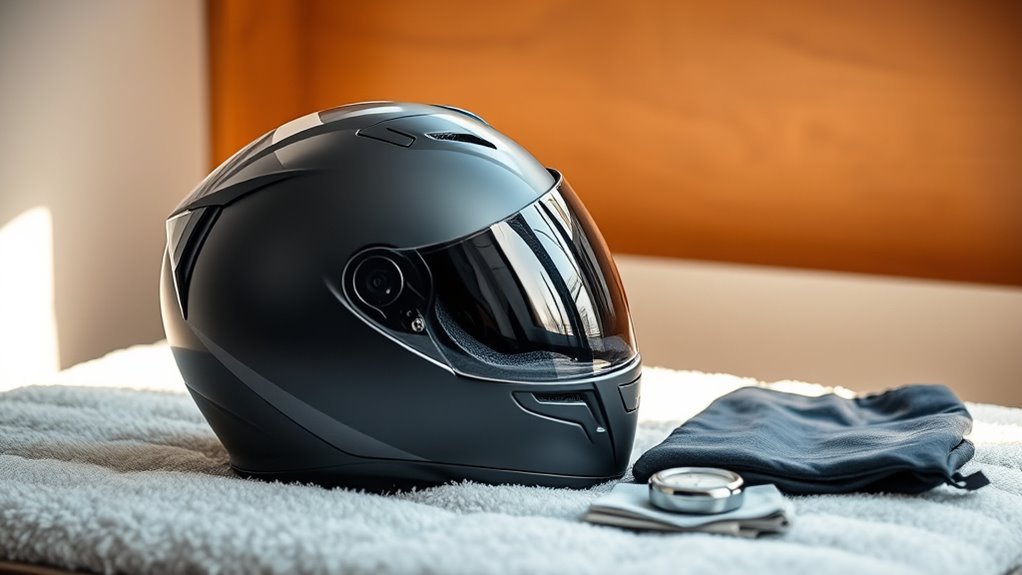
When you’re considering how to store your helmet, it’s vital to understand the materials it’s made from, as this knowledge can help you maintain its integrity. Helmets typically consist of various material types, including polycarbonate, fiberglass, and expanded polystyrene. Each of these materials contributes to the helmet’s impact resistance, which is essential for protecting your head during accidents. Polycarbonate offers durability and lightweight properties, while fiberglass provides superior strength at a slightly higher weight. Expanded polystyrene, often used in the inner shell, absorbs shock effectively. Knowing these characteristics allows you to store your helmet properly, avoiding environments that could degrade these materials, such as extreme temperatures or excessive moisture. Proper storage guarantees your helmet remains reliable when you need it most.
Clean Your Helmet Regularly
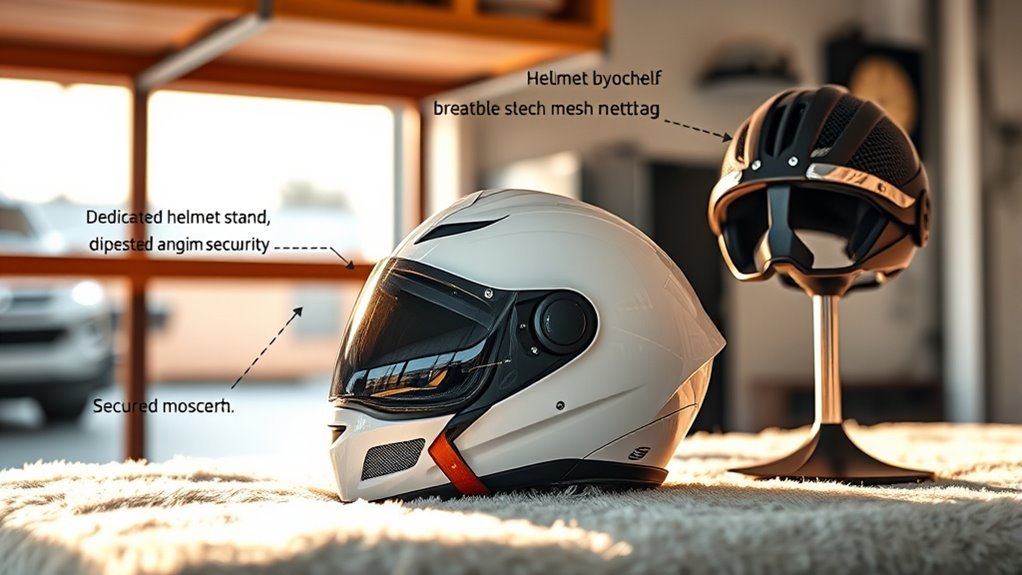
Understanding the materials your helmet is made from is just the beginning; maintaining its cleanliness is equally important for longevity and performance. Regular helmet maintenance involves using appropriate cleaning products to remove dirt, sweat, and oils that accumulate during use. A clean helmet not only looks better but also performs better.
| Cleaning Product | Application Method | Frequency |
|---|---|---|
| Mild soap | Wipe with a damp cloth | After every ride |
| Disinfectant spray | Lightly mist and wipe | Weekly |
| Microfiber cloth | Buff and shine | As needed |
| Water | Rinse interior | Monthly |
| Helmet conditioner | Apply and polish | Every 3 months |
Avoid Extreme Temperatures
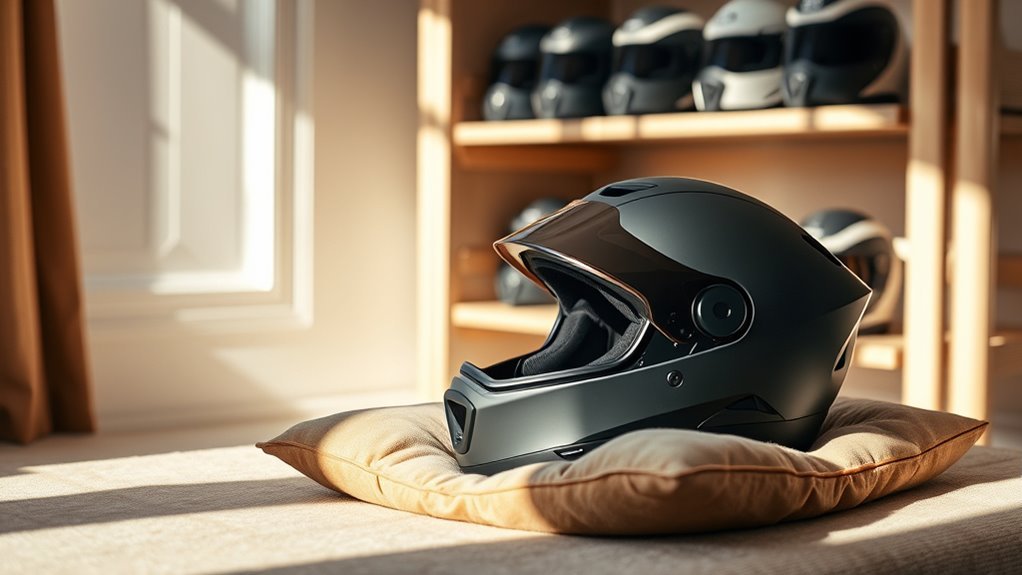
Extreme temperatures can greatly impact your helmet’s integrity and performance, so it is crucial to store it properly. Exposure to temperature fluctuations can weaken the materials and compromise safety features. High humidity levels can also lead to mold growth, further damaging the helmet.
To maximize your helmet’s lifespan, consider these tips:
- Store it in a climate-controlled environment to avoid drastic temperature changes.
- Avoid leaving it in your car or other areas with extreme heat or cold.
- Keep it away from direct sunlight, which can degrade the outer shell.
Use a Dedicated Storage Space
While it may be tempting to toss your helmet on a shelf or in a closet, using a dedicated storage space is crucial for maintaining its condition and guaranteeing its effectiveness. Choose a dedicated shelf or a secure location specifically designed for helmet storage. This prevents accidental drops or impacts that could compromise its integrity. Ascertain the area is free from clutter, allowing for easy access and a clear view of your helmet. A dedicated shelf also aids in keeping your helmet away from other gear that could scratch or damage it. By prioritizing a secure location, you’re taking proactive steps to extend the lifespan of your helmet, ultimately enhancing your safety during rides.
Keep It Away From Direct Sunlight
To make certain your helmet remains in peak condition, it is essential to keep it away from direct sunlight. Sunlight exposure can lead to significant UV damage, degrading the materials and compromising your helmet’s protective capabilities. Here’s how you can protect your helmet from harmful rays:
To ensure your helmet stays in top shape, keep it out of direct sunlight to avoid UV damage.
- Store it indoors, preferably in a cool, shaded area.
- Use a helmet bag or cover to shield it from UV rays when not in use.
- Avoid leaving it on the dashboard or in a car, where sunlight can intensify.
Store It in a Proper Position
When storing your helmet, it’s essential to keep it in an upright position to maintain its shape and integrity. High temperatures can degrade the materials, so choose a cool, dry place for storage. Additionally, consider using a protective cover to shield it from dust and potential damage.
Upright Storage Benefits
Storing your helmet in an upright position offers several advantages that contribute to its longevity and performance. Utilizing effective storage techniques guarantees your helmet maintains its shape and integrity, which is essential for safety. Here are some upright benefits of this method:
- Prevents Deformation: Keeps the helmet’s padding and structure intact, avoiding unnecessary wear.
- Improved Airflow: Allows for better ventilation, reducing moisture buildup and odors.
- Easy Access: Facilitates quick retrieval, making it convenient for spontaneous rides.
Avoid High Temperatures
While it may be tempting to leave your helmet in a warm car or near a heat source, doing so can damage its materials and compromise its safety features. High temperatures can cause significant temperature effects, leading to heat damage that weakens the helmet’s structural integrity. The foam liner may degrade, and the outer shell can become brittle, reducing its ability to absorb impact. To extend your helmet’s lifespan, store it in a cool, dry place, away from direct sunlight or heat sources. Ideally, aim for a temperature-controlled environment. By prioritizing proper storage, you guarantee your helmet remains reliable and effective when you need it most, allowing you the freedom to ride with confidence.
Use Protective Covers
To guarantee your helmet remains in peak condition, using a protective cover is essential. A well-fitted cover not only shields your helmet from dust and scratches but also preserves its structural integrity. Opt for custom covers made from breathable materials to ascertain proper ventilation and prevent moisture buildup.
- Custom Fit: Tailored covers conform to your helmet’s shape, offering maximum protection.
- Breathable Materials: These fabrics allow airflow, reducing the risk of mold and odors.
- Easy Storage: Covers simplify the storage process, making it easy to transport and maintain cleanliness.
Use a Helmet Bag or Cover
A helmet bag or cover is an essential accessory for protecting your headgear from dust, moisture, and potential damage. Whether you own various helmet styles or a single favorite, using a dedicated storage option helps maintain its integrity. A helmet bag typically features cushioning to absorb impacts and prevent scratches, while a cover offers a lightweight barrier against environmental factors. When selecting a bag or cover, make certain it fits your helmet snugly without applying pressure. This not only prolongs the lifespan of the foam and shell but also keeps your helmet looking new. By incorporating a helmet bag or cover into your storage routine, you’ll safeguard your investment and make certain it’s ready for your next adventure.
Inspect Your Helmet Before Storage
Before storing your helmet, it’s essential to conduct a thorough inspection to verify its condition is ideal. This step is critical for guaranteeing your helmet remains safe and functional for future use. Here are some key aspects to focus on:
- Inspect for cracks: Look for any visible damage on the outer shell or inner foam, as even small cracks can compromise safety.
- Check retention system: Confirm that the straps and buckles are intact and functioning correctly, as a secure fit is fundamental for protection.
- Examine the interior: Assess the padding for wear and tear, verifying it remains comfortable and effective.
Frequently Asked Questions
How Often Should I Replace My Helmet?
How often should you replace your helmet? Ideally, you should consider a replacement every three to five years, depending on usage. Look for replacement signs like cracks, dents, or visible wear, as these can compromise your helmet’s lifespan. If you’ve been in an accident, it’s vital to replace it immediately, even if there’s no visible damage. Your safety’s paramount, and a reliable helmet is essential for enjoying your freedom on the road.
Can I Store My Helmet in a Car Trunk?
You shouldn’t store your helmet in a car trunk. Trunk temperatures can fluctuate greatly, exposing your helmet to extreme heat or cold, which can compromise its impact protection capabilities. The materials may degrade, reducing the helmet’s effectiveness in a crash. If you want to preserve your helmet’s integrity and guarantee safety, keep it in a cool, dry place, away from direct sunlight and temperature extremes for best performance.
Is It Safe to Hang My Helmet?
Hanging your helmet might seem like a clever way to display your gear, but it can lead to helmet damage. If you’re using hanging methods that put stress on the straps or shell, you could compromise its integrity. Instead, consider a padded hook or a dedicated storage rack that supports its shape without pressure. By choosing wisely, you can keep your helmet safe while enjoying the freedom that comes with riding.
What Should I Do if My Helmet Gets Wet?
If your helmet gets wet, use proper drying techniques to avoid damage. Remove any liners and padding and allow them to air dry separately. Avoid direct heat sources like radiators, as they can warp the materials. To prevent moisture buildup, store your helmet in a cool, dry place. You can also use silica gel packets to absorb excess humidity. This way, you’ll guarantee your helmet stays safe and ready for your next ride.
Can I Use a Regular Bag for Storage?
You can use a regular bag for storage, but it’s not ideal for helmet care. A bag may not provide the necessary protection from impacts, moisture, or dust. Instead, consider specialized storage solutions designed to maintain your helmet’s shape and integrity. If you do use a regular bag, make sure it’s clean and dry, and avoid compressing the helmet. Keeping it stored properly will extend its lifespan and enhance your riding experience.
